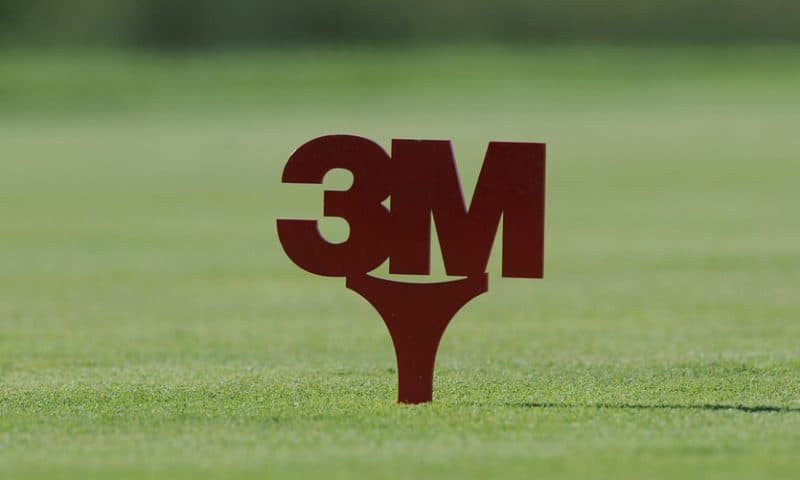Share decline shaves more than 190 points off the Dow’s price, $16 billion off 3M’s market cap
Shares of 3M Co. suffered their biggest one-day decline in over 30 years, after the industrial, health-care and consumer products company missed profit and revenue expectations, slashed its full-year outlook, and said it was cutting 2,000 jobs.
Management admitted that what made first-quarter results even uglier was that the organization failed to react fast enough to the weakness, particularly in its industrial businesses in Asia and the U.S.
The stock MMM, +0.22% dropped 13.0%, as volume swelled to 14.6 million shares, compared with the full-day average of about 1.9 million shares. It was by far the biggest decliner in the Dow Jones Industrial Average. The stock’s price loss of $28.36 acted as a 192-point drag on the Dow DJIA, +0.31% which sank 135 points. The decline also lopped more than $16 billion off the company’s market capitalization.
The percentage decline was second only to the 26% plunge on Oct. 19, 1987. That is the day referred to as Black Monday, with the Dow registered its biggest-ever one-day crash with a 22.6% tumble.
The stock’s selloff comes just two days after the stock had closed at a one-year high of $219.50.
The company behind brands such as Post-it, Scotch, Nexcare and Command, reported first-quarter results before Thursday’s open, showing net income of $891 million, or $1.51 a share, from $602 million, or 98 cents a share, in the same period a year ago. Excluding nonrecurring items, such as litigation-related charges and the impact of tax reform, adjusted EPS slipped to $2.23 from $2.50, missing the FactSet consensus of $2.49.
The litigation-related charges included the establishment of $235 million in reserves to resolve environmental matters related to the manufacture and disposal of waste containing PFAS (perfluorinated compounds) and a $313 million increase in respirator reserves to resolve current and expected future coal-mine dust lawsuits.
Excluding those charges, operating margins fell to 21.4% from 23.0% last year.
Sales declined 5% to $7.86 billion from $8.28 billion, below the FactSet consensus of $8.03 billion. Geographically, sales surprisingly fell 0.4% organically in the U.S., declined 4% in China/Hong Kong and fell 7% in Japan, while growing 1% in Latin America/Canada and EMEA (Europe, Middle East and Africa).
The following table details how 3M’s business segments performed overall:

Analyst Jim Corridore at CFRA reiterated his hold rating on 3M while cutting his stock price target to $205 from $215, saying the quarter was “bad across all fronts.”
And kudos to J.P. Morgan analyst Stephen Tusa, who got even more bearish last month by reiterated his underweight rating and cutting his price target to $154 from $158, citing an “increasingly apparent trade-off” between sales and margins.
3M cut its guidance range for 2019 adjusted EPS, which excludes litigation-related charges, to $9.25 to $9.75 from $10.45 to $10.90.
The company said it was taking “aggressive actions” to improve productivity, reduce costs and boost cash flow, including cutting its workforce by 2,000 positions, across all business groups. That represents a workforce reduction of about 2.1%, based on 93,516 employees at the end of 2018, according to the company’s annual report.
“We continued to face slowing conditions in key end markets which impacted both organic growth and margins, and our operational execution also fell short of the expectations we have for ourselves,” Chief Executive Mike Roman said, according to a transcript provided by FactSet.
On the post-earnings conference call with analysts, Chief Financial Officer Nick Gangestad said the industrial business saw a “broad-based slowdown across most of its portfolio,” highlighted by a 9% drop in its automotive business, including a 6% decline in car and light-truck builds.
As the company witnessed the lower volumes through the quarter, it responded by cutting output at its factories by 4% to 5%. “Unfortunately, we did not pull spending down proportionately,” Gangestad said on the call.
“[W]e didn’t respond aggressively enough to what we were seeing, and so we’re behind the curve as we came through the quarter,” CEO Roman added. “That is why we’re stepping in aggressively, the actions that we are.”
3M’s stock has now edged up 0.1% year to date, while the SPDR Industrial Select Sector exchange-trade fund XLI, +0.75% has soared 19.5% and the Dow has gained 13.4%.

